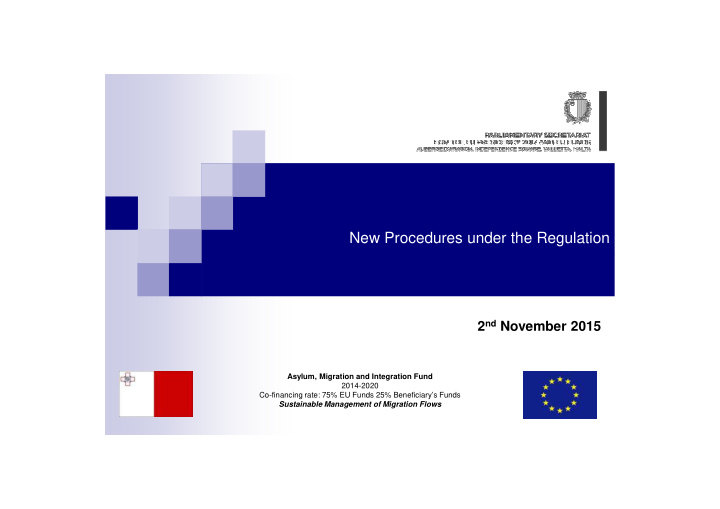



New Procedures under the Regulation 2 nd November 2015 Asylum, Migration and Integration Fund 2014-2020 Co-financing rate: 75% EU Funds 25% Beneficiary’s Funds Sustainable Management of Migration Flows
Content � The Payment Procedure (new IT system to be adopted) � Budget Components (introduction of a new component) � New Eligibility Rules � New Procedures for SOEs � New Procedures in Regulation – Clearance of Accounts / Annual Implementation Report
The Payment Procedure � Beneficiary receives request for payment from contractor (or the finance unit within the beneficiary organisation in the case of reimbursement requests). Following vetting of the request and confirmation of its adequacy, beneficiary performs an online checklist (Invoice Status Certificate) and uploads the necessary supporting (Invoice Status Certificate) and uploads the necessary supporting documents as required in the Migration and Security Information System. � The RA receives and email notification altering him/her to the uploaded documents and the pending authorisation. As part of this authorisation the RA has to perform an online checklist (ISC). � Treasury receives an email notification of the RA’s authorisation and performs an online checklist (ISC) and executes the payment.
The introduction of a new budget component Staff Costs A. Service Costs B. Travel and Subsistence Costs C. Equipment Equipment D. D. Real Estate E. Consumables and Supplies and General Services F. Subcontracting G. Costs Deriving directly from the requirements linked to Union Co- H. Financing Expert Fees I. Specific Expenses in relation to the Target group J. Indirect Eligible Costs K.
The introduction of a new budget component Service Costs Eligibility Rule 2.1: When the services of an organisation involved on � a project exceeds a certain reasonable threshold (number of persons involved above which calculation of individual rates may be unreasonably time-consuming), it is accepted that a service cost per hour is established by the implementing organisation with respect to the implementation of the project. Using such service rate of the cost incurred is however accepted provided that evidence is provided of the total cost incurred of the organisation in a year and the percentage of cost that was allocated to the implementation of that project. Eligibility Rule 2.2: The rate can only be based on expenditure � incurred by the organisation and cannot be applied where services required are subject to a procurement procedure.
The new Eligibility rules � The Eligibility rules have now been drafted at National level. Similar rules have been kept from those present under the previous programming period however new ones have been introduced to facilitate matters. introduced to facilitate matters. For example as a simplification process ‘Costs incurred below - the sum of €100 will no longer be eligible in cases where indirect costs have been approved for the project.’ (This does not apply in cases of advanced contingency money granted to forced returnees under forced return measures.)
The Drawdown of Funds from the European Commission - The verification process prior to the submission of a claim for payment to the European Commission has been changed to cover changes introduced by the Regulations whereby the Certifying Authority was done away with. There are three different levels in the verification process. - At project level: this process is undertaken by the RA desk officers 1. At Specific Objective level : this process is undertaken by the Senior 2. Manager or Director. At Fund Level : Upon receipt of an SOE from the Senior Manager or 3. Director, the FCU undertakes verifications based on a risk management and sampling basis
The Request for the Annual Balance The Drawdown of Funds from the European Commission will be done yearly through the submission of a Request for payment of the Annual Balance, which covers expenditure incurred between 16 th October of year ‘N-1’ and ending on 15 th incurred between 16 October of year ‘N-1’ and ending on 15 October of year ‘N’ (the financial year). � In line with article 44 of Regulation (EU) no 514/2014, by 15 th February of the year following the financial year, the RA shall submit to the Commission the documents and information required under Article 59(5) of Regulation (EU, Euratom) No 966/2012. The documents submitted shall serve as the request for payment of the annual balance from the EC.
The role of the Audit Authority & the Clearance of Accounts The Audit Authority would need to perform an audit yearly - following the end of the financial year till the submission of the Annual Balance to the Commission by the 15 th of February of the following year, to carry out its Audit and submit an Audit the following year, to carry out its Audit and submit an Audit Report. Then by 31 May of the year following the financial year, the - Commission shall decide on the clearance of the annual accounts of each National Programme.
The introduction of the Annual Implementation Report & Project Progress Report - As for the ESI funds there is now the requirement on the RA to submit by 31 st March of each year an Annual Implementation Report. - The Annual implementation report is meant to provide updates to the European Commission on the implementation of the Fund. - The Annual implementation Report will be based on the Project Progress Report which will need to be submitted annually by the Beneficiaries providing an update on the project.
Thanks for your Attention Asylum, Migration and Integration Fund 2014-2020 Co-financing rate: 75% EU Funds 25% Beneficiary’s Funds Sustainable Management of Migration Flows
Recommend
More recommend